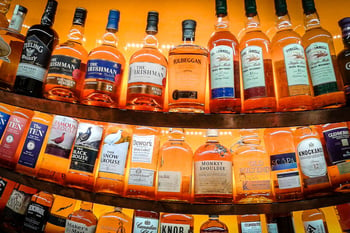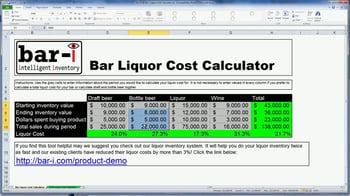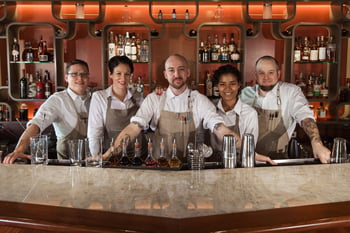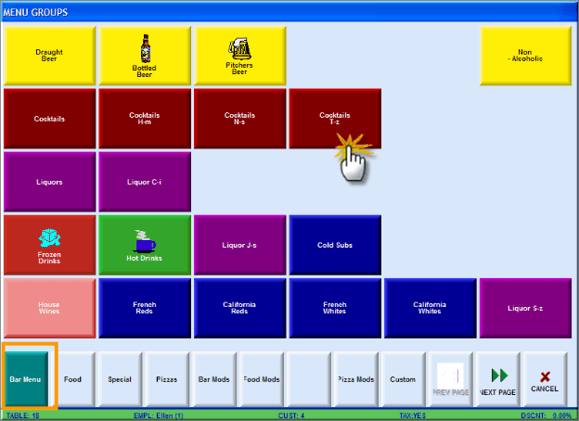Performing bar inventory involves much more than simply counting bottles to figure out how much product has been used and what you have remaining on-hand. When you use a sophisticated inventory system, you can leverage your efforts to obtain a lot of valuable information that will help you run your bar much more effectively. Ultimately, this data can be used to help you make significant improvements to your profitability.
With the right inventory system, you can manage many of the essential tasks necessary to run your bar at optimal levels. Below are 10 essential tasks that can be handled as part of the inventory process.
Ordering
Ordering is one of the most crucial tasks to get right. You need to determine precisely what needs to be ordered so that you don’t run out. However, you also don’t want to over-order and get stuck with lots of dead stock taking up space in your storeroom. Doing a quick count enables you to figure out the right amount to order so that you always have enough product on-hand.
 If all you’re going to do with your inventory efforts is count bottles to see what needs to be ordered, then you should organize the bar so that there is a set amount of product behind the bar at all times. This allows you to skip counting partial bottles behind the bar. If you know that on average you always have one partially full bottle behind the bar for every product you serve, you’ll be able to focus your efforts on making sure you have the proper amount of back stock for each product in the storage area.
If all you’re going to do with your inventory efforts is count bottles to see what needs to be ordered, then you should organize the bar so that there is a set amount of product behind the bar at all times. This allows you to skip counting partial bottles behind the bar. If you know that on average you always have one partially full bottle behind the bar for every product you serve, you’ll be able to focus your efforts on making sure you have the proper amount of back stock for each product in the storage area.
Simply count all the bottles in your storeroom and set pars for each product to ensure you always have enough on-hand. Keep in mind that the pars for more popular products should be higher than the pars for less popular products since you’ll need a larger back stock for the most popular items you sell.
Bar-i’s inventory system automates the ordering process for you. We speed up inventory by using scales and software to count every bottle behind the bar in the quickest and most accurate way possible. When you finish counting, our software not only crunches the numbers to provide you with actionable data, but it also tells you how much of each product needs to be ordered:
- Our basic system compares static pars to current stock to determine orders. This means you enter the par you want to have on-hand for each product you carry.
- The pro version of our system utilizes dynamic pars to make this process even more effective. As your sales volume for each product changes, the par levels will update so that you always have the right amount of each product on-hand based on how much you’ve been selling recently.
- In both cases, you’ll receive an ordering guide that is organized by distributor. This saves you time by making it easy to determine exactly what needs to be ordered from each liquor rep you work with.
Calculating Inventory Values
Inventory values refer to the dollar amount of each product that you have on-hand. To calculate this value, multiply the quantity on-hand by the purchase price of the product. For example, if you have 10 bottles of Jack Daniels and each bottle costs you $20, then you have $200 of product on-hand. You should always do this for every product you sell in order to determine the inventory values you have on-hand.
Often, these inventory values are required by bar owners and/or bookkeepers to calculate liquor cost. At Bar-i, we encourage bar managers to calculate liquor cost themselves. It’s simple to do and important for managers to understand how this process works.
Your bookkeeping process should be able to tell you what your purchase amounts are during a given inventory period. Make sure you keep the following in mind when determining purchase amounts:
- Exclude keg deposits
- Make sure to keep track of credits
When keg deposits and credits aren’t accounted for, it can result in a bouncing liquor cost.
Calculating Liquor Cost
 Determining your liquor cost is a great way to measure the efficiency of your bar. Liquor cost refers to the portion of each sales dollar spent on purchases. For example, if your liquor cost is 18%, then for every dollar in sales, on average you’re spending 18 cents purchasing product.
Determining your liquor cost is a great way to measure the efficiency of your bar. Liquor cost refers to the portion of each sales dollar spent on purchases. For example, if your liquor cost is 18%, then for every dollar in sales, on average you’re spending 18 cents purchasing product.
Liquor cost varies based on the specifics of each bar. As a result, there’s no ideal liquor cost to aim for. Bar-i clients have a liquor cost that varies between 14% on the low end and high-20’s% on the high end. It’s definitely worth tracking this figure to determine how efficiently your operations are running. Lowering your liquor cost over time can equate to a significant increase in profits.
Track Price Increases
This is one of the things that is most often overlooked when running a bar. After all, it’s easy to sign off on deliveries without checking them in, especially when your managers are busy handling other important aspects of running your bar. You won’t make significant profitability improvements from tracking price increases, but by staying on top of this aspect of your business, you can certainly experience modest improvements.
In states where you can receive free products, you want to make sure you’re not getting overcharged. Often, you may receive a product for free a few times and then the distributor will start including it on your order automatically. If you don’t want to carry these products, this will be an important way to ensure you don’t start getting charged for products you never ordered and don’t want.
If you negotiate deals for buying in bulk, you’ll want to make sure distributors are maintaining those prices throughout the duration of the deal. Very rarely are errors in the favor of bar owners, but we’ve seen numerous occasions where these errors result in bar owners paying more money than they should for particular products.
Bar owners who use Bar-i’s pro inventory system will have their invoices reconciled for them and receive a price change report. We do this data entry by going through your invoices line by line in order to calculate usage. As part of this process, we update prices whenever we see a change, and you’ll receive a price change report itemizing these adjusted values. This report makes it easy for you to hold distributors accountable when these changes have occurred in error.
Optimize Pricing
Setting prices for the drinks you sell is an important task to get right since it will have a significant impact on your overall profitability. You definitely want to be strategic about your pricing decisions.
Bar-i recommends the following tips to help you optimize your pricing:
- Compare your liquor cost on individual products within a given category (draft beer, bottled beer, liquor, wine) to identify opportunities.
For example, if you look at the liquor cost of all your draft beer products, you may want to focus on the liquor cost for the highest 20% of products in this category to figure out if this higher liquor cost is being caused by excessive comping, wastage or setting the price too low. You can then address these issues to lower the liquor cost of these poorly performing products. - Determine the right balance between margin and sales volume.
 If you sell a product for a lower price, you’ll sell more of it, but you’ll make less money per sale. You want to identify the right balance between these factors that will generate the most overall profits. In general, you’ll have better liquor costs on your less expensive products (well liquors, domestic beers, etc.). However, be careful about overemphasizing liquor cost. If someone is going to come in and order 4 drinks, you should care more about how many dollars in total you make from that customer’s visit than the margin you’re making on each drink.
If you sell a product for a lower price, you’ll sell more of it, but you’ll make less money per sale. You want to identify the right balance between these factors that will generate the most overall profits. In general, you’ll have better liquor costs on your less expensive products (well liquors, domestic beers, etc.). However, be careful about overemphasizing liquor cost. If someone is going to come in and order 4 drinks, you should care more about how many dollars in total you make from that customer’s visit than the margin you’re making on each drink.
Bar-i often recommends being more aggressive with the pricing of your call and premium products even if it means you’ll run a slightly higher liquor cost on these products. This creates greater incentive for the customer to upgrade to a higher-end liquor, which will ultimately result in more expensive tabs and therefore more money coming into your bar.
Having a reputation for providing good value is typically a better approach than having a reputation for serving cheap drinks. Serving cheap drinks will often result in customers more consistently ordering your low end products, which limits the amount of money being spent at your bar.
These strategic pricing decisions are crucial to the success and profitability of your business. Bar-i will work with you to arrive at the right balance between margin and sales volume that will help you maximize the amount of money coming into your bar.
Calculate Ideal Liquor Cost
Calculating your actual liquor cost is pretty easy to do. It’s more challenging to calculate what your liquor cost would be if no product was missing. Due to the complicated nature of this calculation, many bars will compare their current liquor cost with the previous month’s figure. A common false assumption to make is that if liquor cost was 21% last month and it’s down to 20% this month, it must be a sign that your bar is doing as well as it can since this figure is trending in the right direction.
However, this is often not the case. If your inventory shrinkage is 15-20% (which is industry standard), your bar is actually running costs that are 3-4% higher than they should be.
Determining your ideal liquor cost (the liquor cost if no product was missing) requires the precise calculation of what should have been used through POS recipes. For example, if the Jack Daniels button on your POS was pressed 100 times and each drink should have 1.5 oz. of liquor, then you should have used 150 oz. of Jack Daniels during this inventory period.
By comparing that 150 ounces to what was actually poured during the inventory period, you can compare your actual liquor cost to what it should have been if no product was missing. This ideal liquor cost is an important target to aim for. The closer you can get to this ideal liquor cost, the better your profitability will be.
Hold Staff Accountable
 Ultimately, the performance of your staff is want impacts liquor cost and other figures that determine your profitability. If you don’t have detailed data from your inventory efforts, you can’t provide your staff with the specific feedback necessary to improve performance and maximize profits.
Ultimately, the performance of your staff is want impacts liquor cost and other figures that determine your profitability. If you don’t have detailed data from your inventory efforts, you can’t provide your staff with the specific feedback necessary to improve performance and maximize profits.
This detailed data allows you to complete the feedback loop. In order to have an intelligent conversation regarding the performance of your bar, you need to discuss this data with your staff and use this information to improve performance.
Successful bars have great people working there. Treating your staff well and having a collaborative process with your staff is the best way to hold them accountable, keep them happy at work and improve your bar’s profitability.
Manage Inventory On-Hand
It’s important to properly manage the amount of inventory you keep on-hand. You never want to run out of a product, but at the same time you also don’t want to take up space unnecessarily with excess amounts of product that won’t be used for months.
There’s no standard amount of inventory to keep at your bar. The right amount of product to have on-hand varies based on your sales and the purchasing preferences of your customers.
Bar-i reports calculate your inventory/usage ratio. This figure is arrived at by dividing the amount of product you have on-hand by the amount you used each week. The number of products you carry will impact this ratio because larger product selection is often associated with an increase in dead stock at your bar.
In general, we caution against carrying too many products at your bar. We’ve found that most bars can actually benefit from reducing their product selection and being more strategic about what they carry.
It’s also important to be strategic with the quantity of each product you purchase. Case deals can lower your purchase price, but it can also result in having a lot more product on-hand than is needed. In our experience, we’ve found that the optimal level to shoot for is to carry 4 times the amount of product on-hand as you use each week. Many bars have 8-10 times the amount of product on-hand as they use, and this results in unnecessary dead stock.
At Bar-i, we work with our clients to help them reduce the amount of inventory they keep on-hand to a more sustainable level, which frees up capital to invest in other areas of your bar and prevents your storeroom from being overrun with bottles that will take months to get used.
Optimize Your POS Setup
Ideally, each drink served at your bar should have its own button on your POS system. Not only will this help you to more accurately track what is being sold at your bar, but this is also the best way to ensure that you’re not leaving profits on the table.
Generic modifiers such as “double” or “rocks” typically charge a fixed price increase across the board for every product. This isn’t smart. A higher-end liquor should have a larger upcharge for these drink types than a well liquor since the cost of the product is higher. Customers who are ordering the premium liquor are willing to pay extra for this product, so by using the same upcharge for well and premium liquors, you’re leaving a lot of money on the table.

In our experience, we’ve found that the way you program your POS system is more important than the actual system you use. It takes a bit of time and effort to program your POS properly to ensure that every drink served at your bar has its own button. However, the time you invest in this process will pay big dividends over the long run in terms of your profitability, making it well worth the time and effort.
It’s also important to make sure that you keep up to date with the buttons on your POS system. Whenever you change products or create new drinks, you should create all necessary buttons for these products and drinks in your POS, including specific buttons for variations of the product such as “rocks” or “double.”
If you’d like to learn more about how Bar-i can help you improve your bar’s performance and maximize profits, please contact us today to schedule a free consultation. We serve clients nationwide from our offices in Denver, Colorado.



-1.png)